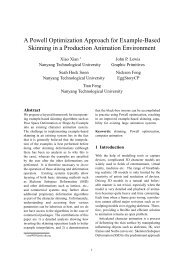Pose Space Deformation Notes - JP Lewis
Pose Space Deformation Notes - JP Lewis
Pose Space Deformation Notes - JP Lewis
You also want an ePaper? Increase the reach of your titles
YUMPU automatically turns print PDFs into web optimized ePapers that Google loves.
PSD(SSD(model), corrections)<br />
to<br />
SSD(model + PSD(corrections2))<br />
where ”corrections” are what the animator sculpts, and ”corrections2” are some other<br />
displacements that produce the same effect when passed through SSD().<br />
Here’s a description of how the Powell’s method could be used to effect this change of<br />
order<br />
s = the sculpted (moved) vertex<br />
p = the orignal vertes<br />
d = the movement by the user<br />
s = SSD(p) + d = SSD(p+e)<br />
we want to find e (e=corrections2). This can be setup as a minimization problem,<br />
minimize(e): | s - SSD( p+e ) |ˆ2<br />
so, the function to minimize is<br />
f(e) = | s - SSD( p+e ) |ˆ2<br />
if this f() can be expressed as computer routine (that calls Maya to get the value of<br />
SSD()), then this f() can be given to the Powell method to find the minimum of e.<br />
In the case of pure SSD() it is possible to find the inverse directly, however in the<br />
”Maya” situation where<br />
1. the skinning is a somewhat unknown algorithm,<br />
2. the skinning process is user-adjustable and the particular rig may have other<br />
components such as blendshapes, lattices,...<br />
this general approach makes more sense.<br />
See Xiao Xian, et al, A Powell Optimization Approach for Example-Based Skinning in<br />
a Production Animation Environment, Computer Animation and Social Agents (CASA<br />
2006) for further details and an illustration of why the SSD-last ordering is preferable.







